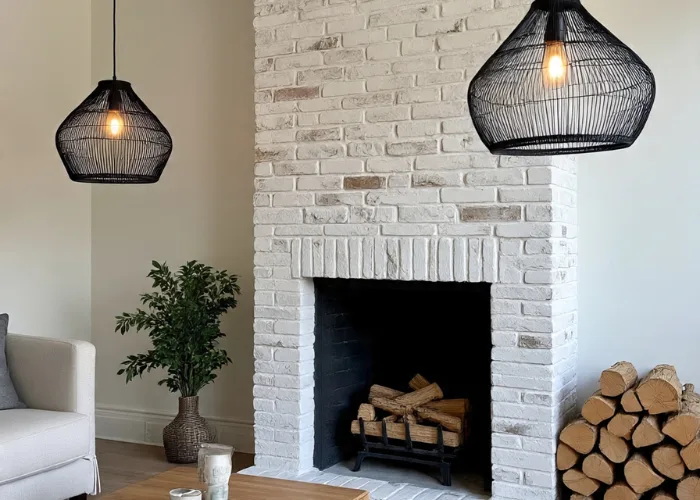The Best Simple Way To German Schmear Brick

If you’re looking for a way to revamp your brick fireplace or exterior with a classic rustic appearance, German Schmear could be the ideal solution. This method involves the application of an extremely small amount of mortar over the surface of bricks is becoming a more well-known method of reviving brickwork in both commercial and residential. It doesn’t matter if you’re transforming the brick fireplace in your home or upgrading the exterior brickwork of your home or constructing a distinctive accent wall in the kitchen area, German Schmear is a great option to create a unique and authentic look without having to commit to a full-on remodel.
In this article we’ll go over the finer points the German Schmear construction. We’ll also discuss how it compares to other techniques such as painting or lime wash and how to do it yourself. From materials to techniques We’ve got everything covered. Let’s take a look at everything you should know before you begin this German Schmear work!
What Is German Schmear?

The German Schmear can be described as a treatment technique which is the process of spreading an even layer mortar on bricks to give them an older, aged and rustic appearance. The word “Schmear” comes from the German word that means “spread” or “smear,” and the method involves spreading the mortar in a thin layer over the brick and then wiping it away leaving a soft texture. This technique works for stone fireplaces and brick exteriors and adds a fresh visual dimension to your home’s design.
The German Schmear technique is preferred by homeowners who are looking for an organic, European-inspired design. It’s a great option for those wanting the warmth of a fireplace made of stone or the rustic look of brick exteriors but without the harsh appearance of painted or whitewashed surfaces. It’s possible to do it on brown brick, red brick, stone, or even faux brick walls for a an updated, modern look.
What Is German Schmear?
If you’re deciding between German Schmear or lime wash or painting the exterior of your house it’s essential to know the difference between them. Here’s the way German Schmear compares to the rest of the market:
German Schmear German Schmear vs. Limewash:
oth the limewash as well as German Schmear provide a more soft and more natural appearance than conventional paint but limewash typically offers a more translucent look that allows the brick to be seen through. German Schmear is, on contrary is a stronger and more opaque layer which gives it a more rough rustic look. It’s ideal for people seeking more coverage, or to cover the imperfections of older bricks. Limewash is ideal for soft tones, however German Schmear is the best choice for those who want to limit the strength of the finish, and make more noticeable differences in hue.
German Schmear and. Painting
If you’re deciding between painting or German Schmear take a look at the following: German Schmear provides a more natural, layered appearance as opposed to painting, which can often appear as if it’s flat or unnatural on bricks. In addition, German Schmear allows the natural brick’s texture to show through, while paint may protect the brick from air and keep its air from flowing. If you want to preserve the quality of your brick but still freshen it up, German Schmear is your best option.
Is German Schmear Permanent?
German Schmear is basically a permanent paint, however with some caveats. In contrast to traditional paint it won’t peel off with time. However in time the mortared brick could get weathered and appear to be older, which will enhance the rustic appearance. If you decide that you don’t like the appearance the brick can be taken off with an effort-intensive process. Most people find the appeal of German Schmear will only increase with age.
Is It Cheaper to German Schmear or Paint Your House?
The price of German Schmear in comparison to painting is largely based on the type of paint you choose to use and the size of the work. German Schmear requires a special mortar that can be more costly than conventional paint. It is worth noting that German Schmear is also less effort to maintain than paint, which makes it a great investment over the long term. In general, painting may appear cheaper at first but you’ll be having to redo your painting every few years, whereas German Schmear is an option that lasts longer.
Is German Schmear Bad for Brick?
Many people are concerned they German Schmear can cause damage to their stone or brick surfaces. However that, if applied properly, German Schmear is not damaging to stone or brick and actually improves their appearance and longevity. The mortar made of thinset used for German Schmear is made to stick to bricks and when it is applied with a thin layer it lets the brick remain able to “breathe,” which is vital to avoid water damage.
If you’re worried about the risk of causing damage to a fragile surface, such as faux brick or certain stone fireplaces, you can test the method in an area of a smaller size before proceeding.
Do You Need to Seal German Schmear?
It’s not a must in order to protect German Schmear However, doing it can extend the longevity for the process, particularly for stone or bricks that are used on exterior areas that are exposed to elements. Sealing the mortar will help keep the mortar safe from staining and weathering which is especially important when you live in a place that experiences extremely harsh weather. If you’d like to keep your finish looking fresher for longer it is advisable applying a transparent sealer to the masonry following the time that you’ve made sure that the German Schmear has fully dried.
How to German Schmear – The Simple Way
If you’re looking to take on this task by yourself, here’s a quick tutorial on how to Schmear your fireplace made of stone, brick or even imitation brick walls.
Materials You’ll Need:
- White Thinset Mortar
- 5-Gallon Bucket
- Cement Mixing Drill Attachment
- Metal Putty Knife / Trowel (6-inch or 3-inch)
- Grout Bag
- Ladder(s) (for height access)
Steps:
- Clean Your Surface: Wipe your stone or brick thoroughly to get rid of any dirt or dirt. You need a clean, dry surface that allows the mortar to be able to adhere correctly.
- Mixing the Mortar the drill to mix white mortar inside the bucket that holds 5 gallon. It should have a consistency that is firm but it is spreadable.
- Apply the mortar: Using your trowel, or putty knife, apply an even layer of mortar over the stone or brick. Make sections and ensure you apply the mortar evenly to the entire surface.
- Wipe off excess: After the mortar has been applied then use a moist sponge or cloth to clean off any excess mortar, leaving behind an unintentionally smudged, light coating that allows the brick to shine through.
- Let it dry Let it Dry German Schmear time to dries for at minimum 24 hours prior to applying or sealing. The mortar will set and solidify.
When Should You Use German Schmear?
- German Schmear is an excellent choice when you need to:
Revamp an outdated brick fireplace or brick exterior. - Give character to the stone fireplace or exterior.
- Make faux brick look fresh in an organic rustic style.
- Create a unique design with a textured appearance that works perfectly with a range of designs for homes, from modern to traditional.
Where Should You Use German Schmear?
Although German Schmear is a popular choice for brick and stone fireplaces, it’s crucial to think about where you would like this style to be used. It’s typically used on brick exteriors or interior stone walls, however it could also be used to give a unique touch to bathroom backsplashes in kitchens and even wall panels in living rooms.
